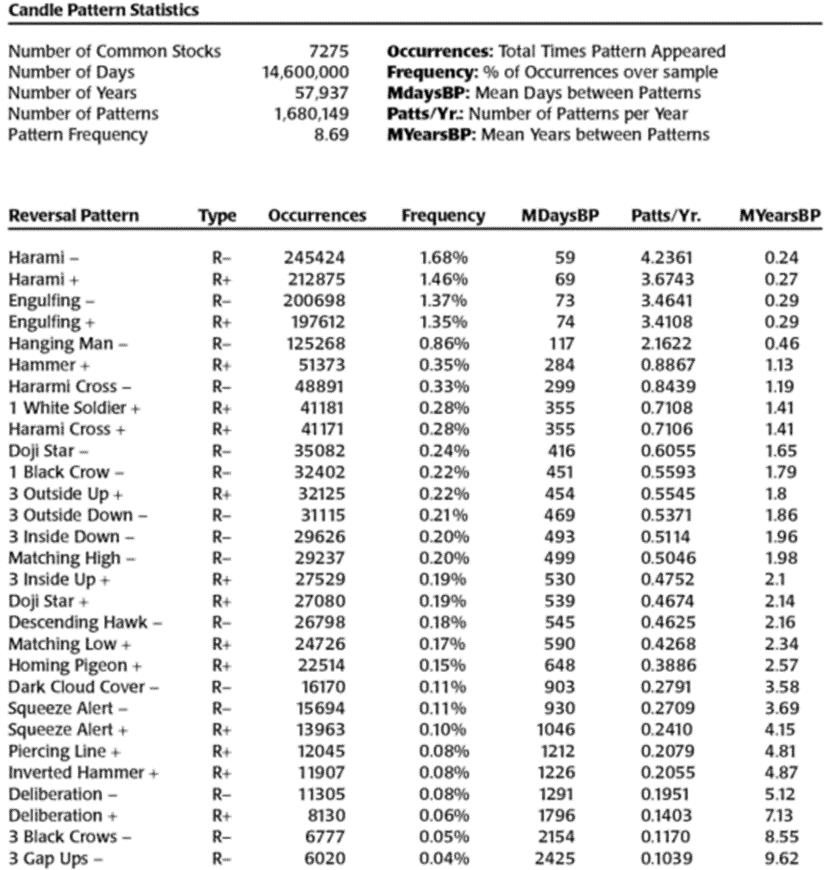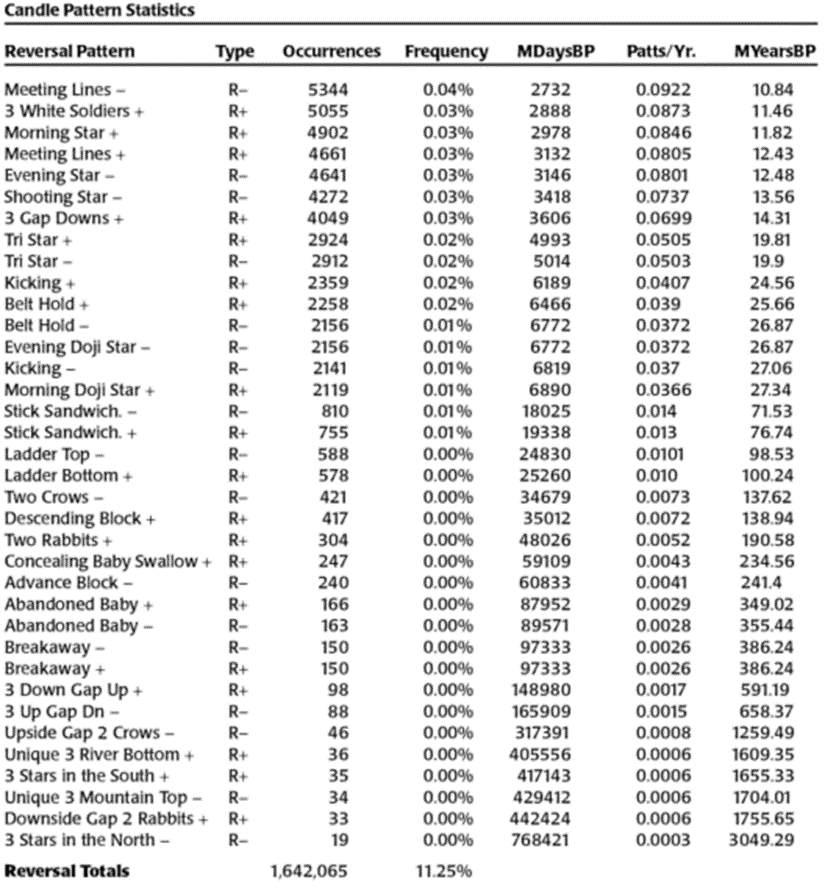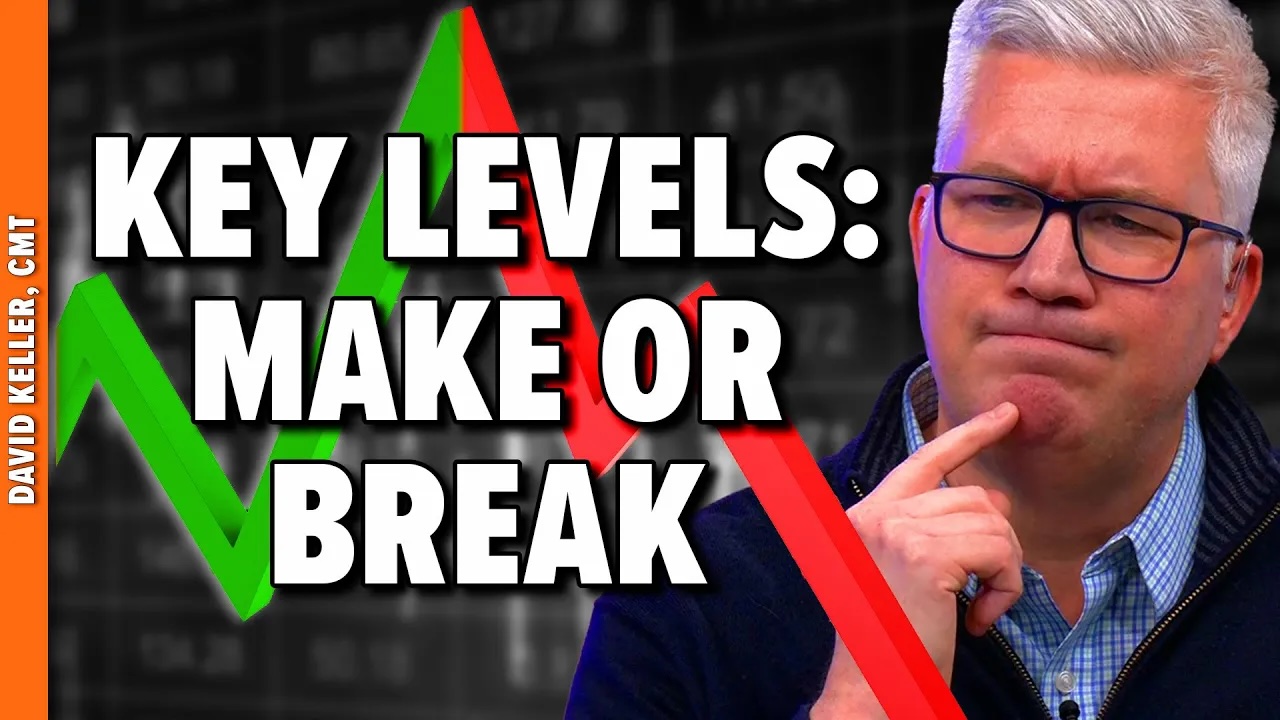 The candle pattern statistics in Table A below show the amount of data used in this analysis, the type of data used, and various other pertinent statistics. All common stocks on the New York Stock Exchange, the Nasdaq market, and the American Stock Exchange were used over a 13-year period. Using stock data prior to late 1991 would distort the analysis because most data services did not provide open prices then. When I wrote the first edition of my book in 1992, I had to use mostly futures data since stock data with open price was rare. Any discrepancies in the summary statistics are because not all of those stocks traded for the full analysis period.
The candle pattern statistics in Table A below show the amount of data used in this analysis, the type of data used, and various other pertinent statistics. All common stocks on the New York Stock Exchange, the Nasdaq market, and the American Stock Exchange were used over a 13-year period. Using stock data prior to late 1991 would distort the analysis because most data services did not provide open prices then. When I wrote the first edition of my book in 1992, I had to use mostly futures data since stock data with open price was rare. Any discrepancies in the summary statistics are because not all of those stocks traded for the full analysis period.
A total pattern frequency of slightly more than 11% equates to one candle pattern about every nine trading days, 8.69 to be exact. This represents a good frequency for daily analysis of stocks and futures. Reversal patterns occur about 40 more times often than continuation patterns. This too is important, as it indicates the reversal of a trend caused by changed positions in trading. In this analysis, there were 65 reversal patterns and 23 continuation patterns, which make reversal patterns account for about 74% of all patterns.
It is also interesting to note that only five patterns account for about 6.7% of all patterns. Of this, the Harami pattern accounts for 46% of those five patterns and over 3% of all patterns. Also, please note that some patterns occur quite infrequently. To assess whether or not they have any value, I will address in a future article. When a pattern occurs, you must understand that, statistically, the success or failure does not mean much. Success and/or failure of candle patterns was dealt with extensively in the Recognition Reliability article.
When a particular pattern appears only a few times in a large amount of data, you should realize that its success and/or failure is subject to the time period under study. Do not let statistics interfere with common sense, and certainly be alert for inaccuracies in the data. The number of occurrences gives confidence in the average value obtained. When dealing with small samples of data, it is how the individual values are distributed that is important. For example, if you had only 12 samples and they were all winners, you would be more interested than if there were only 5 or 6 winners.
Remember, candle patterns were used as a visual charting technique for hundreds of years. With computers there is no way to handle the subjectivity that classic chart reading offers. Another factor to consider when using computers is the quality of the graphics screen: its resolution. The screen consists of small dots of light know as pixel elements. If too much data is used, or if the range of the data is too great, then what might appear as equal on the screen would not be so numerically. The smallest size (width) horizontal line could have a price range within itself, not visible to the eye. Not only computer screens, but also computer generated chart books could have this problem. This is why some flexibility must be built into the identification of, and definition of, the classic patterns.
Another computer anomaly arises in handling candle patterns that are within, or part of another candle pattern. A computer will look at the data in chronological order, that is, old data first. As each day is added, a candle pattern may or may not be noted. When a pattern is identified, the results are stored and the process continues. If a bullish Engulfing Day is identified and the next day has a white body with a close greater than the first day of the Engulfing Day, a Three Outside Up pattern is noted and recorded. The data for statistics and testing has been acquired for both patterns. However, only the Three Outside Up pattern will be identified as a candle pattern if it is given higher priority.
I had to break Table A into 3 sections; sorry for the gaps, but it should be viewed as one Table, albeit a large one. The second column (Type) shows R for reversal, + for bullish, - for bearish, and C for continuation. It should also be noted that the 3rd Edition added a number of patterns to the mix. In the original Japanese literature there were many patterns that only had a bullish or bearish version, but not both. A new pattern with a cute name was created to fill in those holes. Some are good and some are not.



Table A
Hopefully, this will give you a feel for the frequency of the various candle patterns. The message here is that some patterns occur quite often and some are extremely rare. Personally, I would avoid both. The next couple of articles will deal with pattern performance over various periods and performance compared to the other candle patterns.
 I’m sad. On February 10, 2016 when I launched this Candlestick Analysis series of articles, I mentioned when I met Ian McAvity in 1988. Ian emailed me shortly afterwards and thanked me for not telling any stories about some of our times together over the years. We also discussed meeting in Florida at the AAPTA conference to play a couple of rounds of golf. Since I wasn’t going we decided to meet in late summer just north of Niagara Falls (Canada) where Ian had moved to a year or so ago. This was good news for me since I knew Ian was feeling better; he had not played golf in a couple of years. Ian passed away on March 16, 2016. Ian McAvity was a master chartist, he could sail through a presentation with 85 charts in 60 minutes and have everyone laughing all the way through. He published his “Deliberations” newsletter for over 40 years and ceased publication a few years ago. Here is a link to tell you more about my wonderful friend, Ian McAvity.
I’m sad. On February 10, 2016 when I launched this Candlestick Analysis series of articles, I mentioned when I met Ian McAvity in 1988. Ian emailed me shortly afterwards and thanked me for not telling any stories about some of our times together over the years. We also discussed meeting in Florida at the AAPTA conference to play a couple of rounds of golf. Since I wasn’t going we decided to meet in late summer just north of Niagara Falls (Canada) where Ian had moved to a year or so ago. This was good news for me since I knew Ian was feeling better; he had not played golf in a couple of years. Ian passed away on March 16, 2016. Ian McAvity was a master chartist, he could sail through a presentation with 85 charts in 60 minutes and have everyone laughing all the way through. He published his “Deliberations” newsletter for over 40 years and ceased publication a few years ago. Here is a link to tell you more about my wonderful friend, Ian McAvity.
Dance with the Trend,
Greg Morris






